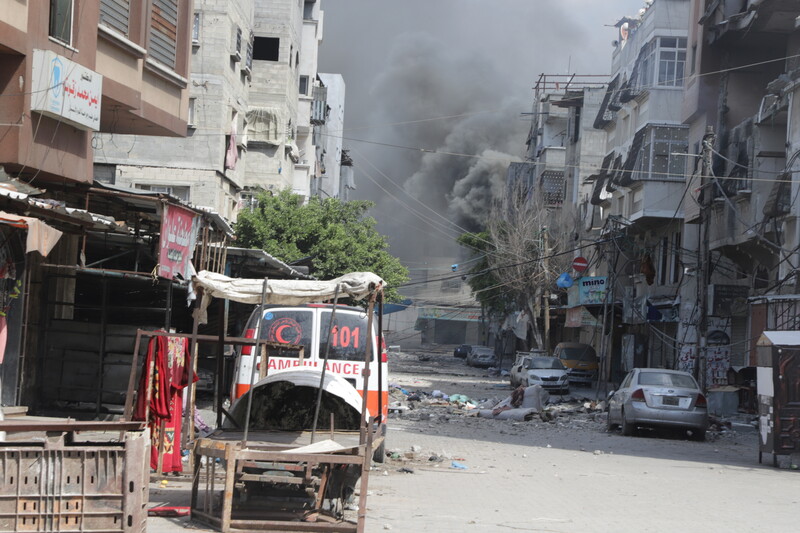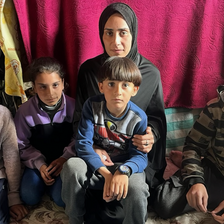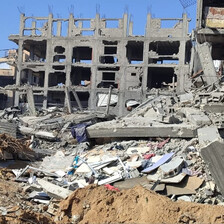The Electronic Intifada 12 January 2025

Israel’s repeated attacks on Jabaliya refugee camp have been deadly and have led to hasty flight to other dangerous locations.
Xinhua News AgencyOn 6 October 2024, 15-year-old Zamzam al-Ajrami was having lunch in northern Gaza with her mother and sisters, Saja, 21, and Lamis, 23. They were taking shelter at the UNRWA center in Jabaliya refugee camp following the Israeli invasion of northern Gaza that had started the previous day.
Zamzam told The Electronic Intifada that it was the first time they had eaten meat in 10 months, made possible through aid from UNRWA, the UN agency for Palestine refugees.
Suddenly, Israeli airstrikes began, launching shells and bombs, while Jabaliya was besieged by drones. This prompted Zamzam’s mother to suggest relocating to the nearby UNRWA Rehabilitation Center for the Disabled.
She said it would be safer, as it was located among narrow streets and densely packed houses, unlike the main road where they were sheltering at the time. Zamzam recalled her mother saying, “From the rehabilitation center, we can escape if we get surrounded.”
They reached the center at 4 pm. It was overcrowded with displaced people.
The family went to the third floor for shelter. The bombing continued relentlessly, terrifying their mother.
She decided to ask nearby families if they planned to stay or leave, intending to follow their decision.
Just five meters from the door of their room, a shell smashed into Zamzam’s mother.
Zamzam and her sisters rushed to see what had happened, only to find their mother gravely injured. Israel – using a quadcopter drone – targeted anyone who moved and the bombardment continued.
Rescue teams present in the center were busy evacuating casualties from the lower floors.
Saja, according to Zamzam, pleaded with them: “My mother is still alive. Please save her!”
A rescuer tried to reach them, but it was too dangerous because of the drone firing at any movement.
Saja returned to her mother. She was barely breathing.
The young woman tried to dress her mother’s wounds using her hijab. Later, she performed chest compressions in a desperate attempt to keep her mother alive.
Zamzam hopelessly tried to call an ambulance, but the signal was weak. She then tried to call her married sister, Dina, who had evacuated to southern Gaza.
After several attempts, the call succeeded. Dina then called an ambulance in northern Gaza, but the ambulance crew said it was too dangerous to reach Zamzam and her family.
A short time later, her mother died from her wounds. Due to the tight siege and extreme danger, they were unable to even bury her in a cemetery.
Zamzam kept crying and refused to leave her mother. “I slept beside my mother’s corpse, hugging it the whole night,” Zamzam said.
Flight
The three daughters wrapped their mother in her bloodstained clothes and buried her in the room they were sheltering in, covering their mother with debris from the shell that had killed her.
By 9 am the next morning, Zamzam and her sisters managed to flee the center, leaving behind all their belongings and their mother’s interred body.
The road was full of corpses and injured people. Blood was everywhere.
They encountered paramedics about 500 meters away from Kamal Adwan Hospital, where their minor injuries from the shell that killed their mother were treated, and they were given water.
Zamzam explained that escaping the Israeli shells and accompanying dust had left them desperately thirsty.
Two hours later, they went to their aunt’s house in Beit Lahiya. But the bombing continued incessantly, and drones kept them trapped indoors.
No safe place
On 3 November, at 1:30 am, their aunt’s house was bombed. Saja and Lamis were killed.
Zamzam said of the attack: “The house was full of displaced people. My uncle, my aunt and their families were there, about 30 people.”
She added that she and her sisters were in a room that Israel targeted with a tank shell. Her aunt started screaming and calling for help from the neighbors.
Zamzam could not even immediately mourn her two sisters. Due to injuries incurred in the attack, she lost consciousness and woke up in the middle of the road.
One of her aunt’s neighbors managed to get her to the hospital.
Zamzam survived by fluke the strike that killed her sisters, sustaining apparently moderate injuries, including fractures, bruises, burns on her face and back, and a head wound. She was taken to Kamal Adwan Hospital, where her wounds were disinfected, hours after her arrival.
According to the hospital director, Dr. Hussam Abu Safiya, the facility was being subjected to regular bombardments at that time. Medical staff and patients alike were targeted.
Abu Safiya was later seized by the Israeli military in late December and is thought to be at Israel’s Sde Teiman torture camp. Gaza-based human rights organization Al Mezan noted on Thursday that Israeli authorities have “extended the ban on his access to legal counsel until 22 January” and an Israeli court extended his detention until 13 February.
Zamzam’s aunt, who had been left at the hospital with her, was still alive. Kamal Adwan Hospital told them that Zamzam’s injuries were serious and needed an X-ray, but there was no functional X-ray imaging facility at the hospital.
The hospital told them that there was an X-ray facility at Al-Awda Hospital in Jabaliya, a dangerous distance from Kamal Adwan Hospital with Israeli forces attacking in the area.
Despite the danger, they managed to arrive at the hospital, where they took an X-ray and put a cast on Zamzam’s foot. Staff at the hospital told Zamzam she could not remain in the hospital due to the lack of adequate services and the overwhelming number of injured people requiring ongoing care.
Unable to stay, her aunt decided they should leave and take refuge at a relative’s home in Beit Lahiya. On 5 December, the area where they were sheltering was warned of an impending attack, forcing Zamzam to leave on foot despite her injuries, as Israeli forces prohibited the use of ambulances.
On the morning of that December day, while Zamzam, her aunt and her aunt’s family were considering what they should do, their course of thought was interrupted by the sound of a quadcopter ordering Abu Tamam School in Beit Lahiya to evacuate. Those departing were told the school would be stormed and to head to western Gaza.
The whole family immediately evacuated the house.
Zamzam recounted to The Electronic Intifada that while they were walking she “saw many bodies lying on the ground.” She added, “I could smell the corpses filling the streets. A quadcopter was watching us and shooting at anyone who tried to go back.”
The teenager was forced to walk on her injured foot. “My broken foot and my wounds were the biggest obstacle I faced during my displacement journey,” she said.
Zamzam managed to reach the Shujaiya neighborhood. From there, she went west into Gaza City and is now receiving treatment at al-Shifa Hospital.
But the hospital’s resources are insufficient. The medical equipment she needs for foot surgery is lacking.
It’s been a painful and deadly journey for Zamzam since her 6 October 2024 meal with her mother and sisters at the Jabaliya UNRWA center.
Khaled El-Hissy is a journalist from Jabaliya in the Gaza Strip. He is currently in Jordan for medical treatment. Twitter: @khpalestined
A second author is based in Gaza but has chosen to remain anonymous.





